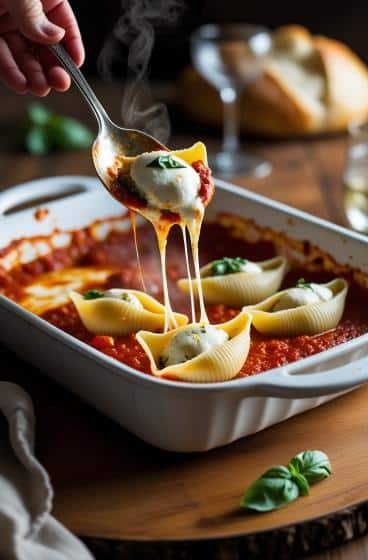Ever had a dish so comforting, so rich, yet surprisingly simple, that it feels like a warm hug from your Nonna? Ricotta stuffed pasta shells deliver exactly that. This recipe takes humble jumbo pasta shells and transforms them into little pockets of creamy, cheesy heaven. Stuffed with fresh ricotta, herbs, and sometimes a sneaky hint of nutmeg or parmesan, they’re baked in a luscious tomato sauce until bubbly and golden. It’s one of those dishes that speaks to your soul, reminding you why Italian food has captured hearts worldwide.
Ricotta stuffed shells are special because they balance textures and flavors so effortlessly. The soft, creamy filling contrasts with the al dente pasta, while the tomato sauce brings brightness and a hint of acidity to cut through the richness. Plus, this dish is incredibly versatile — from classic herbaceous fillings to hearty additions like spinach or sausage. The culinary technique of stuffing pasta is ancient, yet endlessly adaptable, making it a staple for both home cooks and professional kitchens. Let’s dive into the magic of this dish and uncover the secrets that elevate it beyond the everyday.
Ingredients & Substitutions
Getting your ingredients right is half the battle won. The quality of ricotta especially makes a world of difference. Fresh, whole-milk ricotta gives you that luscious, slightly grainy texture that clings to the shells like a dream. Avoid the watery supermarket stuff if you can. For herbs, fresh basil or parsley will brighten the filling, while dried herbs can sometimes feel flat or muted, so fresh is king here.
Below is a handy table listing ingredients and substitutions for different dietary needs or preferences.
| Ingredient | Purpose | Substitutions | Notes |
|---|---|---|---|
| Jumbo pasta shells | Vessel for filling | Gluten-free pasta shells | Cook shells al dente to avoid mushiness |
| Ricotta cheese | Creamy filling base | Cottage cheese (drained), tofu (silken, blended for vegan) | Fresh whole milk ricotta preferred for flavor and texture |
| Parmesan cheese | Umami, saltiness | Nutritional yeast (vegan) | Grated finely for smooth incorporation |
| Mozzarella cheese | Melty topping/filling | Vegan cheese shreds | Use fresh mozzarella for best melt and flavor |
| Fresh basil/parsley | Herbaceous aroma/flavor | Dried herbs (use sparingly) | Fresh herbs add brightness |
| Egg | Binding agent | Flax egg (vegan) | Helps hold filling together |
| Garlic | Flavor enhancer | Garlic powder | Fresh minced garlic preferred |
| Tomato sauce | Base for baking | Marinara or homemade sauce | Use a sauce with balanced acidity |
| Salt & pepper | Seasoning | N/A | Adjust to taste |
| Nutmeg | Warmth, subtle spice | Ground cinnamon (small pinch) | Optional but adds complexity |
When selecting pasta shells, look for ones that hold their shape well after cooking. Avoid thin shells prone to tearing. For ricotta, if you can’t find fresh, drain the container over cheesecloth for 10-15 minutes to remove excess moisture. This prevents the filling from becoming watery.
Fresh herbs versus dried is a classic conundrum. In this dish, fresh herbs keep the filling lively and aromatic, while dried ones might overpower or dull the delicate ricotta. If dried herbs are your only option, reduce quantity by half and add at the right time to preserve flavor.
Step-by-Step Instructions
Making ricotta stuffed shells sounds fancy, but honestly it’s pretty straightforward once you break it down.
- Cook the pasta shells
Bring a large pot of salted water to boil. Add jumbo pasta shells carefully and cook them just al dente — about 8-9 minutes depending on the brand. Drain and rinse with cool water to stop cooking. Toss lightly in olive oil to prevent sticking. Avoid overcooking or shells will fall apart when stuffed. - Prepare the ricotta filling
In a bowl, combine ricotta, grated parmesan, beaten egg, minced garlic, chopped fresh herbs, salt, pepper, and a pinch of nutmeg. Mix gently to keep the ricotta’s creamy texture intact. Taste and adjust seasoning. Avoid overmixing as you want it fluffy, not dense. - Stuff the shells
Using a small spoon or piping bag, fill each shell generously but gently. Don’t overstuff or shells might split. Arrange stuffed shells snugly in a baking dish pre-coated with a thin layer of tomato sauce to prevent sticking. - Top with sauce and cheese
Cover shells with more tomato sauce, ensuring even coverage. Sprinkle shredded mozzarella evenly on top for a bubbly, golden crust. - Bake
Preheat oven to 375°F (190°C). Cover baking dish with foil and bake for 25 minutes. Remove foil and bake an additional 10 minutes or until cheese is browned and sauce bubbling.
Expert tips:
- To avoid soggy shells, don’t over-sauce the dish before baking. Keep sauce just enough to cover but not drown the shells.
- Use a piping bag for cleaner, faster stuffing.
- For even cooking, space shells close but not crowded.
- Let the dish rest 10 minutes after baking before serving — it firms up and flavors meld better.
Common mistakes to avoid:
- Overcooking pasta shells: they’ll tear during stuffing or bake into mush.
- Using watery ricotta: drains excess moisture to prevent watery filling.
- Overfilling shells: they burst and release filling into sauce.
Variations:
- Add sautéed spinach or kale to ricotta for a veggie boost.
- Mix cooked Italian sausage or ground beef into filling for meat lovers.
- Spice it up with red pepper flakes or cayenne.
- Use vegan ricotta and cheese substitutes for dairy-free options.
Cooking Techniques & Science
Why does this method work so well? Stuffing pasta is a technique dating back centuries, showcasing Italian ingenuity in turning simple ingredients into layered dishes. The pasta acts as a container, holding a rich filling that might otherwise be loose. Baking allows the flavors to mingle, while the sauce keeps pasta moist and the cheese on top caramelizes for texture.
The binding role of egg in the filling is critical. It coagulates under heat, giving structure to the ricotta mixture, so it doesn’t run when baked. Nutmeg, often overlooked, is a warm spice that complements the dairy and herbs, enhancing umami without overpowering.
Tomato sauce adds acidity that balances the creamy ricotta, and its natural sugars caramelize during baking, giving subtle sweetness. Mozzarella’s fat melts beautifully, creating a luscious, golden blanket over the shells.
Storing leftovers? Cover tightly and refrigerate for up to 3 days. Reheat gently in the oven at 350°F (175°C) covered with foil to keep moisture, or microwave in short bursts to avoid drying out.
For freezing, assemble the dish without baking, cover tightly with foil and plastic wrap, then freeze up to 3 months. Bake directly from frozen, adding extra baking time and keeping covered until thoroughly heated.
Tools that make a difference:
- A shallow baking dish ensures even cooking and proper cheese browning.
- A piping bag for filling shells saves time and yields neat results.
- Fine grater for parmesan avoids clumps in filling.
Serving & Pairing Suggestions
Presentation elevates this dish beyond the plate. Garnish with fresh basil leaves or a sprinkle of parmesan to add color and a final aroma burst. Serve with a crisp green salad dressed in lemon vinaigrette to cut richness.
For wine pairing, a medium-bodied Chianti or a fruity Pinot Noir pairs beautifully with the tomato sauce and creamy cheese. Non-alcoholic? Sparkling water with lemon slices refreshes the palate.
Side dishes like roasted vegetables, garlic bread, or even a light minestrone soup make this meal well-rounded. For a heartier feast, add a prosciutto and arugula salad.
Best Time to Serve
Ricotta stuffed shells fit perfectly into cozy family dinners or special gatherings. Their make-ahead potential means you can prep in advance for a stress-free Sunday meal or a midweek treat. They shine in fall and winter when hearty, comforting meals are most welcome.
They’re also a fantastic vegetarian option for meatless Mondays or anytime you want indulgence without heaviness.
Conclusion
Ricotta stuffed pasta shells are a classic for a reason: the harmony of creamy filling, tender pasta, vibrant sauce, and melty cheese is pure comfort food magic. Mastering the art of proper shell cooking and moist, flavorful filling elevates the dish from good to unforgettable.
Always choose fresh ricotta and herbs if possible, drain excess moisture, and bake covered before finishing uncovered to get that perfect bubbly cheese top. Don’t be shy about personalizing the filling with your favorite add-ins — from spinach to sausage or spices.
This recipe is a testament to how simple ingredients and traditional techniques combine into a dish that feels like home.
FAQs
Q1: Can I prepare ricotta stuffed shells ahead of time?
Absolutely. You can stuff shells and assemble the dish a day ahead. Cover and refrigerate, then bake just before serving. For longer storage, freeze assembled (unbaked) shells and bake from frozen.
Q2: What can I use instead of ricotta?
For a similar texture, use well-drained cottage cheese or a vegan ricotta made from blended tofu and lemon juice. Both work but alter flavor slightly.
Q3: How do I prevent shells from sticking?
After boiling, rinse shells under cold water and toss lightly with olive oil. When placing in the baking dish, coat with sauce to help prevent sticking.
Q4: Can I make this gluten-free?
Yes, use gluten-free jumbo pasta shells available at specialty stores. Cook carefully as gluten-free pasta can be fragile.
Q5: Why does my filling get watery?
Usually because ricotta or cottage cheese is too wet. Drain cheese in cheesecloth for 10-15 minutes before mixing. Also avoid adding extra liquid ingredients to the filling.
Ricotta stuffed pasta shells are a joyful blend of texture, flavor, and tradition. Perfect the technique, choose ingredients with care, and you’ll have a dish that warms any table, any time.

